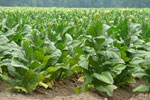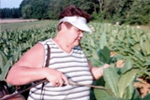Tobacco Worker Health
Tobacco Worker Facts: Tobacco is the nation’s ninth highest valued crop and is grown in 16 states. Kentucky and North Carolina produce about 2/3 of all domestic tobacco, although tobacco is also grown further north in places like the Connecticut River Valley to make cigar wrappers.
Tobacco Facts: The main hazards to tobacco workers result from handling it and the manual labor tasks surrounding planting, maintaining and harvesting. These activities differ significantly between shade tobacco and field grown tobacco. Tasks information presented here relates primarily to shade tobacco, although many of the hazards are similar.
Shade and broadleaf tobacco: Grown in the Connecticut River Valley, used for cigar wrappers and fill, fields are covered with gauze or nets to shield tobacco plants from direct sunlight. Methods used to cultivate and harvest this tobacco differ significantly with methods used to cultivate and harvest cigarette tobacco: Less wet conditions: for a leaf to be marketable, it has to be blemish-free — no spots, holes or creases. They blemish easier when the plants are wet, so workers rarely harvest wet tobacco leaves. Less dermal contact: After leaves are picked, they are balanced briefly on the forearm, and then transferred to a conveyor (not held under arm).
Burley tobacco, flue-cured and Maryland tobacco: Grown throughout eastern coastal states, Kentucky and Tennessee mainly for cigarette production; burley tobacco contains 13% more nicotine than flue-cured tobacco.
 Tobacco Worksite Visit (Shade Tobacco)
Tobacco Worksite Visit (Shade Tobacco)
 Common Tobacco Hazards
Common Tobacco Hazards
 Tobacco Research Articles and Other Links
Tobacco Research Articles and Other Links